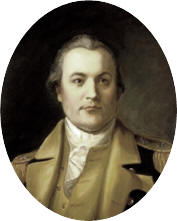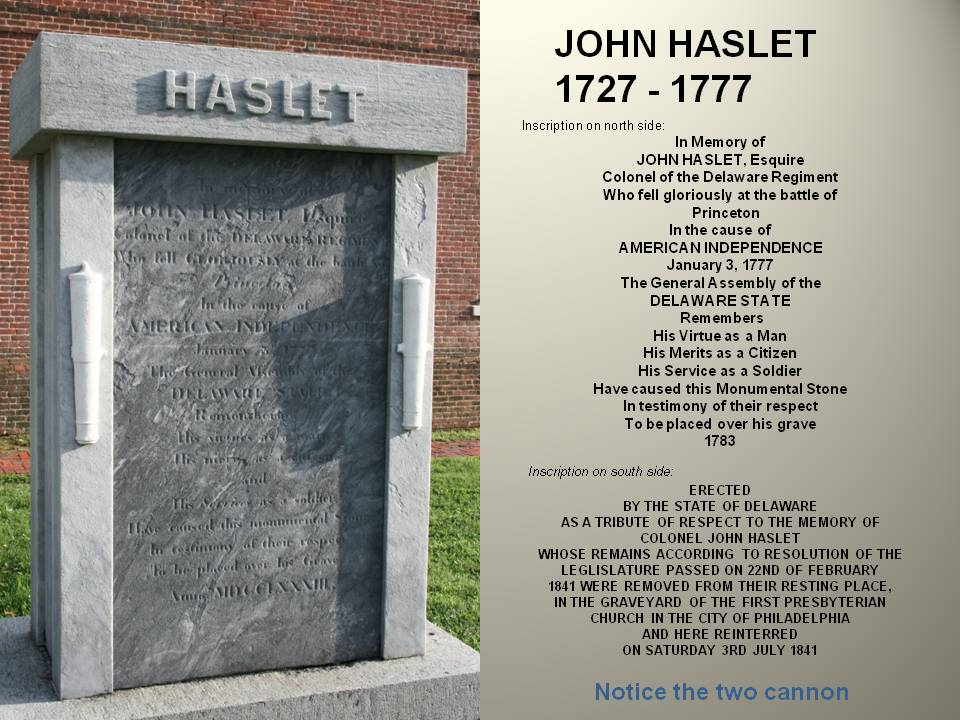|
Colonel John Haslet (1727 - 1777)
American patriot, Veteran of the French
and Indian War and the American Revolutionary War
 John Haslet was born in Dungiven, Co Derry Ireland in 1727, the first of six children born to Joseph Haslet and Ann Dykes
Haslet. John Haslet was born in Dungiven, Co Derry Ireland in 1727, the first of six children born to Joseph Haslet and Ann Dykes
Haslet.
John's father was a merchant and tenant farmer who probably managed to provide a decent standard of living for
his family. The Haslets were of Presbyterian stock whose ancestors settled in Ulster sometime during the Plantation of Ireland(1) which spanned the 16th and 17th centuries.
After completing his early education in Ireland he
went on to study at the University of Glasgow where, in 1749, he earned a Masters Degree in Divinity . He was licensed by the Derry Presbytery in 1750, and ordained a minister in 1752. He married Shirley Stirling in 1750 who died a few year later during the birth of their daughter.
During his years in Ireland, Haslet witnessed the plight of his Catholic neighbors who were subjected to a series of draconian and repressive measures collectively known as the Penal Laws. Provision of these laws denied Catholics the right to practice their religion, denied them the right to an education, prevented them from owning property or holding office and barred them from any undertaking that would improve their lot. Presbyterians did not fare much better. They were subjected to many of the same provisions of the Penal Laws as their Catholic neighbors.
As a consequence, there was an exodus of Scotch -Irish to America in the latter half of the 18th century. Haslet joined the exodus arriving in America circa 1757. He settled in and shortly afterwards was commissioned a Captain in the Pennsylvania Militia. He served in the
French and Indian War and was
a participant in the expedition
that captured Fort Duquesne in 1758.
Many of those Scotch-Irish who fled Ireland wound up in in the ranks of Washington's Continental army. The unintended consequence for England was that their former victims contributed enormously in both talent and manpower to their defeat by the Continental army primarily made up of rebellious subjects from their colonies augmented by unforgiving former Irish victims. Haslet's participation played no small role in that outcome.
After his service in the
Pennsylvania
militia ended he relocated to Milford in Delaware
where he served as a Presbyterian minister and also as a
medical doctor. Being a leading proponent of Independence and a passionate advocate of individual freedom he was appointed a colonel by the Continental Congress in 1775 and charged with raising the Delaware Regiment to fight for independence alongside patriots from the other colonies.
In the Summer of 1776 when
Haslet brought his newly formed regiment to New York State for the Battle of Brooklyn, also known as the Battle of Long Island, he had more than 800 men under his command. During the ensuing battle, the Delaware regiment fought alongside the Maryland regiment under the command of Brigadier General William Alexander. They were
given
the
task
of
holding the Gowanus Road on the far right of the Continental Army line.
They
did
their
job
well
and
held
the
British
army
at
bay
long
enough
to
allow
the Continental army sufficient time to
retreat
and
avoid destruction by the much larger and battle hardened
British army.
Haslet
was
fearless
in
leading
his
men
during
the
fighting
and
held
his
ground
until
ordered
to
withdraw by General Alexander. During the battle and the bloody retreat that followed the Maryland regiment lost up to 400 men; Delaware fared much better losing only 31.
After the defeat in Brooklyn the Continentals moved north through Manhattan engaging the
pursuing British in numerous battles and skirmishes including encounters at Kips Bay, Harlem Heights, New Rochelle, White Plains and Fort Washington in upper Manhattan. With the exception of a victory of sorts at Harlem Heights the Continentals were no match for the better equipped and battle hardened English army. Haslet and his men, who were engaged in all of these battles, took heavy losses and by the time they reached Pennsylvania the regiment was reduced to 100 men.
After fleeing across New Jersey during the month of November, the Continentals, including what was left of Haslet's regiment, crossed the Delaware into Pennsylvania to escape the pursuing British army. At that point the British gave up the chase and returned to Manhattan to wait out the Winter months. Washington, anticipating the British would assume that the Continentals ware immobilized in Pennsylvania for the Winter months, decided to attack the British garrison in Trenton, New Jersey. He crossed the Delaware River during the night of December 25 and attacked the garrison on the morning of December 26, 1776. The ensuing Continental victory was a turning point in the war. Haslet and his remaining men were in the forefront of that battle.
After their
victory
at
Trenton, Washington and his army returned to Pennsylvania, but not for long. On the night of December 29, they returned to New Jersey to attack the British garrison in Princeton. On January
2,
1777 on the way to Princeton, they engaged a contingent of British troops in Trenton in what is referred to as the second Battle of Trenton. During the night, after the fighting
had ended for the day unbeknownst to the British, Washington left his position and headed north to engage the British garrison at Princeton leaving a few hundred men behind to man fires as a diversionary tactic.
It was during the ensuing Battle of Princeton on January 3 that Haslet was shot through the head and killed. As second in command to General Mercer
he had just taken command after Mercer was killed. Notwithstanding the loss of both Mercer and Haslet the Continentals won the day and forced Cornwallis, the commanding British General, to abandon his remaining outposts in New Jersey and retreat to New Brunswick
Colonel John Haslet's was buried in the grounds of the First Presbyterian Church
in Philadelphia, Pennsylvania. By an act of the Delaware Legislature his remains were disinterred,
brought
back
to
Delaware
accompanied
by
a
military
escort, and
on
July
3,
1841 reinterred in its final resting place
in the Presbyterian Cemetery in Dover, Delaware.
-------------------------------------------------------------------------------------------------
Footnotes:
(1) The purpose of the Plantation of Ireland was to confiscate the lands and property of native Irish Catholics and give it to Scottish, Welsh and English colonists. The so-called plantation, which today would be classified as attempted genocide or at least as ethnic cleansing,
began during the reign of Henry VIII and continued under Mary I and Elizabeth I. The pace accelerated under James I and Charles I. The final official plantations took place under Cromwell during the 1650's after the English Civil War, when thousands of Parliamentarian soldiers were settled in Ireland.
(2) The Penal Laws (1704 - 1793) whose object was to (1) to deprive the Catholics of all civil life (2) to reduce them to a condition of ignorance and (3) to dissociate them from the soil. These draconian and repressive laws originally directed at the native Irish were amended over time to curb the growing influence of the Presbyterians whose loyalty to the realm was suspect. The lot of the Presbyterians worsened over time and by the middle of the 19th century their plight culminated in the Young Ireland Uprising of 1848. when they joined forces with the Catholics in an unsuccessful attempt to break free of England
Contributed by Tomás Ó Coısdealbha
cemetery
AND
grave
location
Name:
Old Presbyterian Cemetery
ADDRESS:
South Governor’s Avenue, Dover, Delaware 19904
HEADSTONE

|